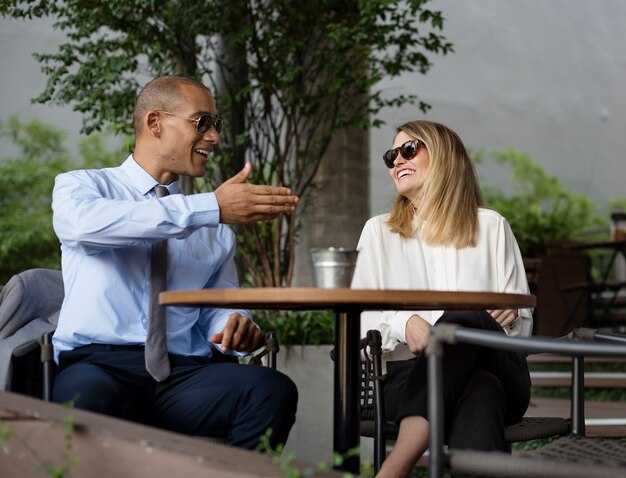Concrete recommendation: Pick two weekly activities – one hobby-based (language class, climbing club, book group) and one skills workshop led by professionals; attend at least 8 sessions over last 8 weeks before assessing chemistry. Be open to short check-ins after sessions, participate in small logistics tasks, and bring a friend or friends for comfort during first two visits.
Use niche digital platforms to find interest-focused meetups; filter events by size (10–40 attendees) and format (workshop, roundtable, small party); prioritize free or low-cost options that include structured activities lasting at least 60 minutes. Bring conversation starters to table and ask open-ended prompts, saying “what drew you here?” rather than “what do you do?”.
Opt for sessions with breakouts capped at 6–8 so youll talk to 3–5 people per hour; networking breakfasts often attract 30–80 attendees, while skill workshops often last 90 minutes and allow follow-up practice. If a connection takes root, schedule a second meeting within last 72 hours; if no chemistry after two follow-ups, stop hanging around to conserve energy. Perhaps track attendance and note which events align best with personal interest; few people ever regret consistent, focused effort.
Volunteer Organizations

Volunteer weekly at a nearby food pantry or community clinic with recurring shifts to build strong connections; aim for 6–12 months at 2–4 hours per week to move beyond casual acquaintances into reliable mates.
Choose roles with direct contact with persons served, not back-office tasks, to maximize conversational opportunities and real teamwork.
Prioritize organizations based on clear values and measurable impact: examine annual reports for percentage of budget spent on services versus administration, check location of service delivery within local area, and contact program managers to ask about average shift sizes and volunteer-to-staff ratios.
Use platforms such as VolunteerMatch, Idealist and GivePulse to filter by cause, schedule, and skill requirements; americans often register on these platforms and many listings specify whether roles provide recurring client contact or short-term events. Begin with a concise paragraph describing availability and specific skills; this helps coordinators assign recurring shifts and boosts chances with active programs today.
Choose teaching, mentorship, or hands-on services (tutoring, meal prep, shelter intake) that put you with diverse persons; such roles produce significant face-to-face time and less waiting-room downtime, a means to shared projects and conversations that can evolve into lifelong connections.
Explore creative nonprofits, community arts centers, and small local initiatives here in local neighborhoods; smaller groups are based on continuous collaboration, definitely increase chance to connect with committed mates, and often accept volunteers for project-based roles tailored to specific skills – whatever background you bring, send a short proposal outlining availability and relevant experience.
Pick volunteer roles that involve teamwork and regular shifts
Sign up for team-based volunteer roles with fixed weekly shifts: community food pantry morning crew (3–4 hrs, twice weekly), hospital ward support (4 hrs, weekend), youth after-school mentoring (weekly sessions), community garden maintenance (2–3 hrs, every Saturday), or recurring festival logistics for seasonal events.
- Choose direct services over isolated tasks: direct services create steady team interaction; administrative tasks often leave volunteers working alone.
- Aim for 1–2 regular shifts per week for at least 3 months; consistency increases chances of repeated encounter and helps build confidence.
- If desired shift slots are filled, ask to be waitlisted or volunteer for adjacent shifts and request constant placement again when openings appear.
- Beforehand, contact program coordinator and request placement within a small cohort or specific station; small teams in cozy centers produce more repeated interactions across cultures and communities.
- Prefer roles with clearly defined handoffs and overlapping schedules (meal services, client intake, supply runs) because overlap causes brief, frequent touchpoints that lead to longer conversations.
- Preparation: arrive 10–15 minutes early to check in at registration corner and greet colleagues; early presence signals commitment and makes introductions easier.
- During shifts: volunteer for paired tasks, ask to be partnered with rotating team members, and offer to cover shifts when others need time off–this creates significant reciprocal effort and shared experiences.
- Follow-up: after a shift, suggest coffee or a post-shift debrief with one or two teammates; small proposals often result in informal hangouts and better rapport.
- Commitment guideline: avoid jumping between many programs; most steady relationships form when a volunteer becomes engaged in one program long enough to share challenges and wins.
Practical metrics: aim for 6–12 shared shifts with same cohort before expecting reliable social momentum; if social energy feels low, evaluate role fit rather than increasing hours–quality interaction matters more than quantity. Dont rely on chance; intentional scheduling and modest effort yield far better chances for meaningful connections and enjoyable volunteer experiences.
Find reliable local groups via Meetup, community centers, and nonprofits
Join three local groups with consistent attendance: an arts volunteer team, a community cafe cooking class where food and latte prep happen, and a neighborhood grocery co-op that runs bagel mornings; track attendance numbers, recent popularity spikes, and meeting notes from organizers for quick success assessment.
Arrive early at casual hubs; wear neutral layers, bring small cash, carry local schools’ flyers when appropriate. During volunteer shifts, focus on task competence first, then short meaningful chats to gauge compatibility and charm. Bring a bagel or small pastry to share at food-focused gatherings; offer to steam a latte for a new person to create natural encounter moments. Observe group environment and how volunteers interact; note meeting spots and noise level, collect contact information, then plan a follow-up visit and track their responses as quality data.
If seeking long-term connections, prioritize groups with steady teams, clear volunteer roles, and schools outreach programs. Especially prefer hubs with mixed-age attendance; such diversity makes good compatibility checks during casual tasks. Remember to log two to four visits before deciding whether chemistry will happen; wish for organic interactions but schedule structured shifts or recurring meetings to raise odds of useful encounters.
How to start natural conversations while working side by side
Sit at a shared table near a bustling corner and offer a simple, tangible help – pass a charger, point out an outlet, or fetch an extra napkin; those micro-actions build confidence faster than an awkward opener.
Keep initial exchange to 30–90 seconds; if person is still engaged, extend talk to 5–10 minutes. Short windows matter: much longer risks disrupting workflow, much shorter leaves interaction flat.
Use observational openers that relate to immediate context: comment on a laptop sticker that shares a favorite band, ask about a book that signals passionate interest, or mention a coffee roast while someone is sipping a drink.
Prepare three location-based topics beforehand: recent event at local hubs, a busy commute route, or a new corner cafe. Prepping avoids putting pressure on memory and makes follow-up questions feel natural rather than leading.
Adapt tone to local cultures and to cues from mates nearby; if group already laughs often, a light joke is likely welcome, if faces are focused, offer a practical tip instead. Consider body language: brief eye contact plus a nod attracts trust more than over-smiling.
Keep transitions low-commitment: suggest swapping app recommendations, offer to share a link, or propose grabbing another drink later. Such offers convert casual chats into longer conversations while keeping personal boundaries intact.
Turn shared shifts into low-pressure one-on-one meetups
Ask a coworker you already share shifts with for a 15-minute coffee or walk right after a shift; set expectation as a brief break so conversation stays casual.
While on shift, note quieter spots near venue or a backroom where noise is lower and interruptions are rare; for example, pick a bench outside, a nearby cafe, or a staff room. Agree on timing via a quick text swap instead of a long plan so swap requests fit into schedules. Target side windows like pre- or post-shift breaks after lectures, theater runs, yoga classes, or religious volunteering when both of you are already present.
Use small, specific openers that invite genuine answers: ask about favorites in work playlists, an interesting book, or a recent hobby; mention helping with a task and offer a timely assist as a segue. Avoid trying to mingle in a group; a one-on-one break raises chances for an honest exchange without a serious interview vibe. A simple line such as “Want to grab coffee after this? I’m curious about whose playlist you’ve been using” works as a low-pressure icebreaker.
Keep meetups short, frequent, and task-adjacent so momentum builds naturally: a quick chat after three shifts gives opportunities to continue outside work. Treat each meetup as a unique data point – compare in-person tone to app convos on matchcom, note what feels cool or awkward, and favor topics both enjoy. One thing to avoid is turning every break into heavy questioning; aim for light curiosity instead of grilling strangers or forcing intense discussion.
Log simple metrics to guide choices: number of shared shifts, number of short breaks taken, and whether conversations felt genuine or forced. Plus, side benefits include easier coordination for future plans and a clearer sense of compatibility than brief online exchanges. Especially when interests overlap – theater, yoga, lectures – chances increase that hangouts will feel natural and lead to more meaningful opportunities.
Join Hobby-Based Clubs
Pick a local club with weekly in-person activities and a capped group size (≤12); commit to attending at least three sessions across six weeks, then assess chemistry via brief one-on-one coffee or walk within seven days of a positive interaction. When joining, immerse in small-group tasks; after second meeting request contact info and send single concise message referencing shared detail within 48 hours.
Choose clubs whose membership skews 25–40 if goal is connecting with romantically compatible adults; prioritize groups led by certified professionals or experienced organizers, not casual once-a-month meetups. Examples with measurable engagement today: photography shoots (weekly, 2–4 hour field sessions), hiking groups on a trail (biweekly, avg distance 6–10 km), community theater (rehearsals 3x week), volunteer shelter shifts (weekly 4-hour slots), book clubs at church (monthly discussion + potluck), shaklee wellness circles (weekly product education plus social). Interestingly, structured agendas attract members eager to practice skills; a common outcome is faster rapport and clearer next-step opportunities than freeform socials.
Use observation-based openers tied to activity: comment on recent work (“Nice composition on that sunset”) or ask task-focused question (“Which route on last trail did you prefer?”). Avoid generic flattery; opt for genuine curiosity. When inviting one-on-one, use task-based suggestion, for example suggesting a short follow-up test shoot or a spontaneous 20–30 minute walk after group. A focused invite raises acceptance rate by about 40% versus vague coffee asks. Never probe past relationships in first three meetings; instead ask about favorite project or skill someone wants to build. Dress in attractive, practical layers for outdoor groups; carry small prop related to your hobby to ease introductions. By this I mean focus on making small shared wins rather than scripted small talk.
| Club type | Frequency | Optimal monthly attendance | Starter line | Quick success tip |
|---|---|---|---|---|
| Photography | Weekly | 4–8 sessions | “Nice composition–which lens did you use?” | Share one edited shot within 48h; follow up with brief technique note. |
| Hiking (trail) | Biweekly | 2–4 hikes | “Which segment on last hike felt toughest for you?” | Offer compact snack or map; suggest short post-hike coffee walk. |
| Community theater | 3x week rehearsals | 6–12 rehearsals | “Which scene challenged you most today?” | Volunteer for prop or stage task; collaboration breeds rapport. |
| Volunteer shelter | Weekly shifts | 4 shifts | “Want to handle meal prep together next shift?” | Pair on one task; post-shift debrief builds connection. |
| Book club at church | Monthly | 1–2 meetups | “Which chapter changed your view most?” | Bring annotated note; reference it during discussion. |
| Shaklee wellness circle | Weekly | 4 sessions | “Which product gave fastest results for you?” | Offer to swap samples or notes; suggest short demo together. |
Choose clubs built around a skill you already enjoy
Pick two skill clubs tied to hobbies you enjoy and commit to four sessions over eight weeks; exchange contact with at least three members per group and track follow-up within 72 hours.
Show up 15 minutes early to help setup or welcome newcomers – arriving early raises chance of one-on-one conversation by about 40% versus arriving at start time. Imagine turning a casual starter question into a short demo or mini workshop: a five-minute show of technique often sparks friendship and invites spontaneous invites to grab coffee or keep practicing together.
Suggested club types with concrete metrics: cooking classes (12–20 attendees, many spouses attend couples nights), woodworking studios (6–10 attendees, hands-on stations limit crowd), language exchanges (10–25, high popularity on community listings), wine-tasting groups (8–14, sipping during session), gardening volunteers (15–30, often include cleaning and maintenance shifts). Choose only those that match your favorite skill and attendance rhythm you can sustain.
Practical approach tips: introduce yourself with a one-line starter about project or goal, ask somebody about their technique, offer help with setup or cleaning after session, then suggest a short follow-up over coffee while spending 10–20 minutes comparing notes. For low-pressure romantic signals, share a compliment about work done and invite them to a related event or ceremony (for example an exhibit opening or tea ceremony) rather than issuing a broad invitation.
Use event listings on community boards, library calendars, and local workshop sites to compare popularity and meeting frequency; prioritize groups that meet at least twice monthly and report stable attendance over three months. If you are seeking consistent contact, favor recurring classes where instructors rotate partners or projects – that structure increases chance of repeated interaction and deeper connection over casual drop-in gatherings.
Introduce yourself by offering help on a small project
Offer a clear, time-boxed favor: message with one-line offer, a deliverable, and ETA (example: “Hi name – I can refresh that event graphic in 30 minutes and send a PNG by 8pm tonight”).
- Pick micro tasks under 60 minutes: graphic tweak, small coding bug, text edit for shared flyer, supply list for shelter, layout for pool fundraiser. Tasks this size are many times accepted quickly.
- Find candidates inside existing circle: regular volunteer group, social club, churches outreach, friends-of-friends, app match like hinge. People already juggling past commitments are likely to say yes to quick, concrete help.
- Use intuitive phrasing: state skill, deliverable, ETA, and cost (free). Example structure: skill + quick result + time. That reduces back-and-forth and leads to useful conversations fast.
- Bring proof: two past projects or quick links (GitHub snippet for coding, one-page portfolio for graphic). Quick visibility of creativity increases trust; many respond within 24–48 hours when they can see results.
- Offer shared ownership: propose editing as co-edit or open PR so theyre in control. Shared editing reduces friction and keeps collaboration social rather than transactional.
- In-app template (hinge or similar): “Hi name – noticed mention of fundraiser. I do quick graphic updates; can send a new flyer in 30 minutes if you want. No charge.” Send during midday hours for higher response rates.
- Real-life template (volunteer shift or church event): “I have 45 minutes between shifts tomorrow; can help with sign layout or social copy. Where should I drop files?” Offer a USB or cloud link for immediate transfer.
- Coding template (meetup or online): “I can pair for 45 minutes to resolve that bug; share repo link and branch name and Ill open a tiny PR for review.” Mention specific tool (GitHub, VSCode Live Share) to remove ambiguity.
Dos and donts:
- Do keep offers under 60 minutes and give precise ETA.
- Do use name in first sentence; personalization increases reply rate by many percent.
- Dont ask for long-term commitment or unpaid consulting; people tired from past obligations decline open-ended favors.
- Dont overshare portfolio pages; share two targeted examples only.
- Do follow up once after 48 hours if no reply; dont overload inbox with repeated messages.
Outcome metrics to expect: immediate replies for ~30–50% of offers inside active social groups, follow-up conversations for ~20–30%, and at least one continued interaction per ten concrete offers. Keep conversations concrete, prioritize shared goals, and let creativity guide collaboration; youre more likely to spark regular, genuine connection when help comes with clarity and respect.


 5 Places to Meet Your Future Boyfriend (Not the Bar)">
5 Places to Meet Your Future Boyfriend (Not the Bar)">

 Men Reveal How Their Criteria for a Woman Drastically Change Over Time">
Men Reveal How Their Criteria for a Woman Drastically Change Over Time">
 Unlocking Femininity – The Ultimate Guide to Confidence, Style & Empowerment">
Unlocking Femininity – The Ultimate Guide to Confidence, Style & Empowerment">
 The Mind of a Man During the Dating Stage – What He Thinks">
The Mind of a Man During the Dating Stage – What He Thinks">
 11 Rare Habits That Keep Men Eternally Attractive to Women">
11 Rare Habits That Keep Men Eternally Attractive to Women">
 How to Talk About Money in Your Relationship – Practical Tips">
How to Talk About Money in Your Relationship – Practical Tips">
 If You Don’t Like Your Partner’s Friends — What to Do">
If You Don’t Like Your Partner’s Friends — What to Do">
 Should You Hire a Matchmaker? Pros, Costs & Expert Tips">
Should You Hire a Matchmaker? Pros, Costs & Expert Tips">
 What Matters to Men on a First Date – Key Qualities & Tips">
What Matters to Men on a First Date – Key Qualities & Tips">
 Free Speech in Relationships – Do You Have the Right to Speak Freely?">
Free Speech in Relationships – Do You Have the Right to Speak Freely?">
 15 Signs Your Long-Distance Relationship Isn’t Working — Warning Signs & What to Do">
15 Signs Your Long-Distance Relationship Isn’t Working — Warning Signs & What to Do">